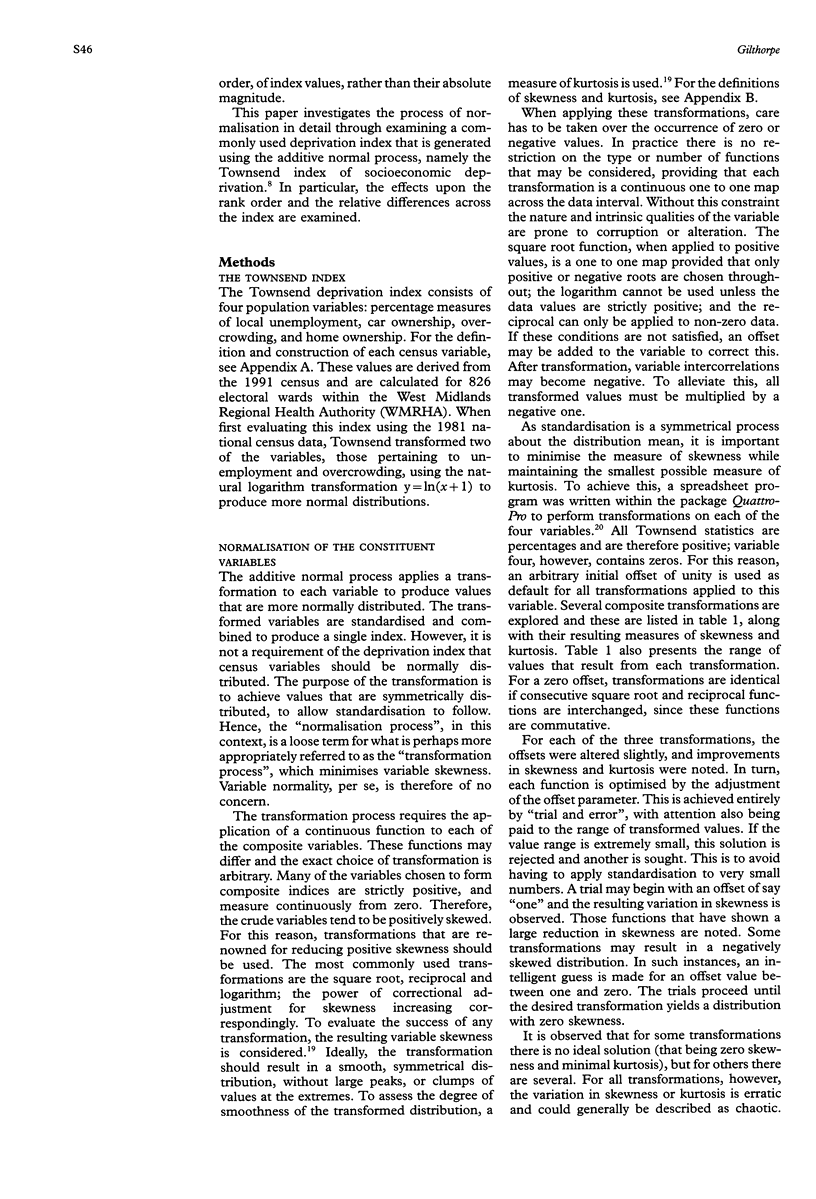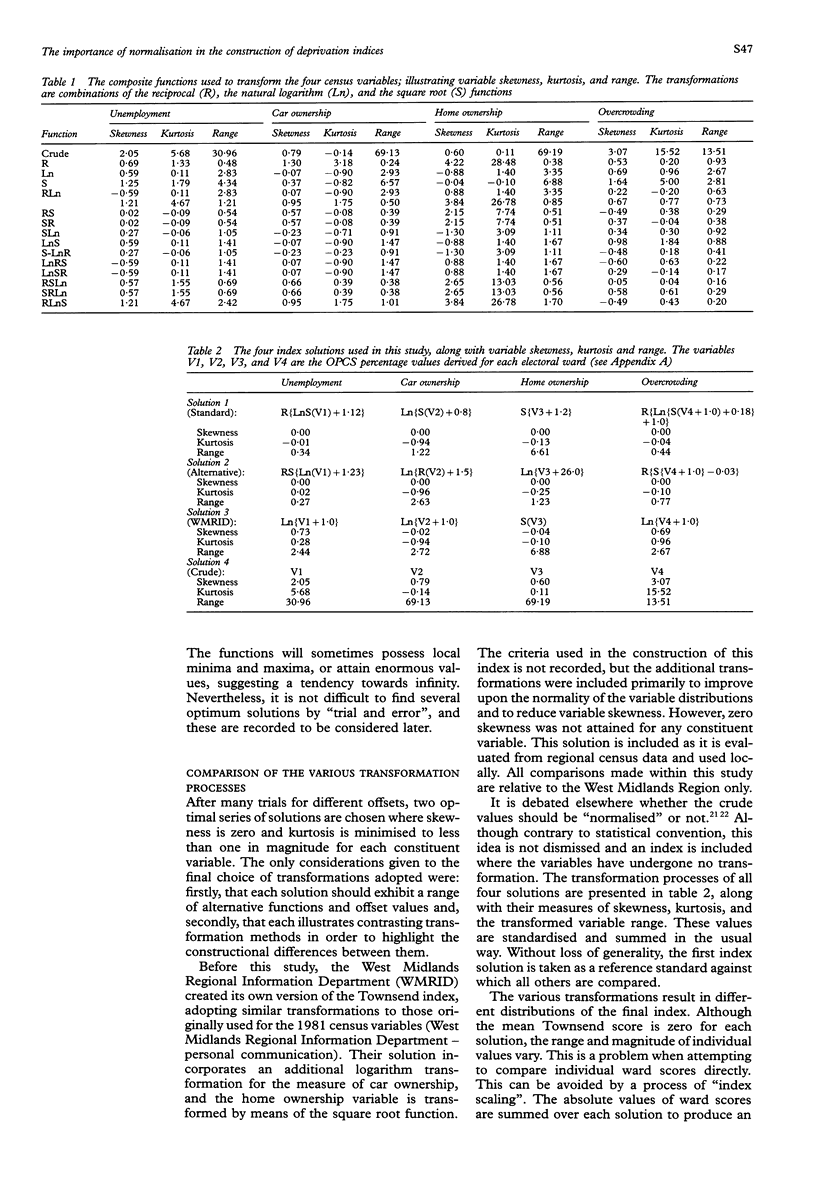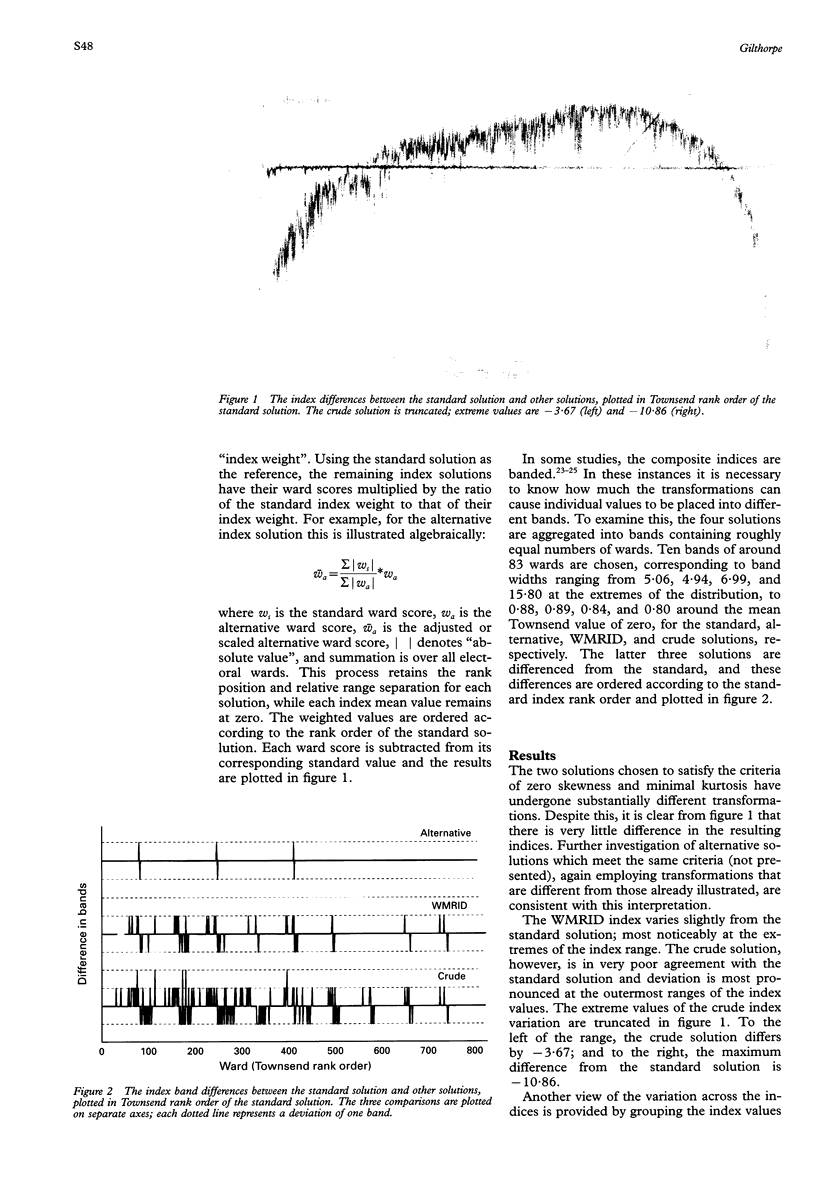Abstract
STUDY OBJECTIVES--Measuring socio-economic deprivation is a major challenge usually addressed through the use of composite indices. This paper aims to clarify the technical details regarding composite index construction. The distribution of some variables, for example unemployment, varies over time, and these variations must be considered when composite indices are periodically re-evaluated. The process of normalisation is examined in detail and particular attention is paid to the importance of symmetry and skewness of the composite variable distributions. DESIGN--Four different solutions of the Townsend index of socioeconomic deprivation are compared to reveal the effects that differing transformation processes have on the meaning or interpretation of the final index values. Differences in the rank order and the relative separation between values are investigated. MAIN RESULTS--Constituent variables which have been transformed to yield a more symmetric distribution provide indices that behave similarly, irrespective of the actual transformation methods adopted. Normalisation is seen to be of less importance than the removal of variable skewness. Furthermore, the degree of success of the transformation in removing skewness has a major effect in determining the variation between the individual electoral ward scores. Constituent variables undergoing no transformation produce an index that is distorted by the inherent variable skewness, and this index is not consistent between re-evaluations, either temporally or spatially. CONCLUSIONS--Effective transformation of constituent variables should always be undertaken when generating a composite index. The most important aspect is the removal of variable skewness. There is no need for the transformed variables to be normally distributed, only symmetrically distributed, before standardisation. Even where additional parameter weights are to be applied, which significantly alter the final index, appropriate transformation procedures should be adopted for the purpose of consistency over time and between different geographical areas.
Full text
PDF





Images in this article
Selected References
These references are in PubMed. This may not be the complete list of references from this article.
- Balarajan R., Yuen P., Machin D. Socioeconomic differentials in the uptake of medical care in Great Britain. J Epidemiol Community Health. 1987 Sep;41(3):196–199. doi: 10.1136/jech.41.3.196. [DOI] [PMC free article] [PubMed] [Google Scholar]
- Ben-Shlomo Y., White I., McKeigue P. M. Prediction of general practice workload from census based social deprivation scores. J Epidemiol Community Health. 1992 Oct;46(5):532–536. doi: 10.1136/jech.46.5.532. [DOI] [PMC free article] [PubMed] [Google Scholar]
- Campbell D. A., Radford J. M., Burton P. Unemployment rates: an alternative to the Jarman index? BMJ. 1991 Sep 28;303(6805):750–755. doi: 10.1136/bmj.303.6805.750. [DOI] [PMC free article] [PubMed] [Google Scholar]
- Carr-Hill R. A., Sheldon T. Designing a deprivation payment for general practitioners: the UPA(8) wonderland. BMJ. 1991 Feb 16;302(6773):393–396. doi: 10.1136/bmj.302.6773.393. [DOI] [PMC free article] [PubMed] [Google Scholar]
- Carstairs V. Small area analysis and health service research. Community Med. 1981 May;3(2):131–139. [PubMed] [Google Scholar]
- Curtis S. E. Use of survey data and small area statistics to assess the link between individual morbidity and neighbourhood deprivation. J Epidemiol Community Health. 1990 Mar;44(1):62–68. doi: 10.1136/jech.44.1.62. [DOI] [PMC free article] [PubMed] [Google Scholar]
- Dye T. D., Lee R. V. Socioeconomic status: developing a quantitative, community based index in rural Kashmir. J Epidemiol Community Health. 1994 Aug;48(4):421–422. doi: 10.1136/jech.48.4.421. [DOI] [PMC free article] [PubMed] [Google Scholar]
- Eames M., Ben-Shlomo Y., Marmot M. G. Social deprivation and premature mortality: regional comparison across England. BMJ. 1993 Oct 30;307(6912):1097–1102. doi: 10.1136/bmj.307.6912.1097. [DOI] [PMC free article] [PubMed] [Google Scholar]
- Jarman B. Identification of underprivileged areas. Br Med J (Clin Res Ed) 1983 May 28;286(6379):1705–1709. doi: 10.1136/bmj.286.6379.1705. [DOI] [PMC free article] [PubMed] [Google Scholar]
- Kelly W. F., Mahmood R., Kelly M. J., Turner S., Elliott K. Influence of social deprivation on illness in diabetic patients. BMJ. 1993 Oct 30;307(6912):1115–1116. doi: 10.1136/bmj.307.6912.1115. [DOI] [PMC free article] [PubMed] [Google Scholar]
- McLoone P., Boddy F. A. Deprivation and mortality in Scotland, 1981 and 1991. BMJ. 1994 Dec 3;309(6967):1465–1470. doi: 10.1136/bmj.309.6967.1465. [DOI] [PMC free article] [PubMed] [Google Scholar]
- Morgan M., Chinn S. ACORN group, social class, and child health. J Epidemiol Community Health. 1983 Sep;37(3):196–203. doi: 10.1136/jech.37.3.196. [DOI] [PMC free article] [PubMed] [Google Scholar]
- Morris R., Carstairs V. Which deprivation? A comparison of selected deprivation indexes. J Public Health Med. 1991 Nov;13(4):318–326. [PubMed] [Google Scholar]
- Payne J. N., Coy J., Milner P. C., Patterson S. Are deprivation indicators a proxy for morbidity? A comparison of the prevalence of arthritis, depression, dyspepsia, obesity and respiratory symptoms with unemployment rates and Jarman scores. J Public Health Med. 1993 Jun;15(2):161–170. doi: 10.1007/BF02959657. [DOI] [PubMed] [Google Scholar]
- Reading R., Raybould S., Jarvis S. Deprivation, low birth weight, and children's height: a comparison between rural and urban areas. BMJ. 1993 Dec 4;307(6917):1458–1462. doi: 10.1136/bmj.307.6917.1458. [DOI] [PMC free article] [PubMed] [Google Scholar]



